英语阅读—世界各地,圣诞风俗各不同
- 格式:doc
- 大小:85.83 KB
- 文档页数:7
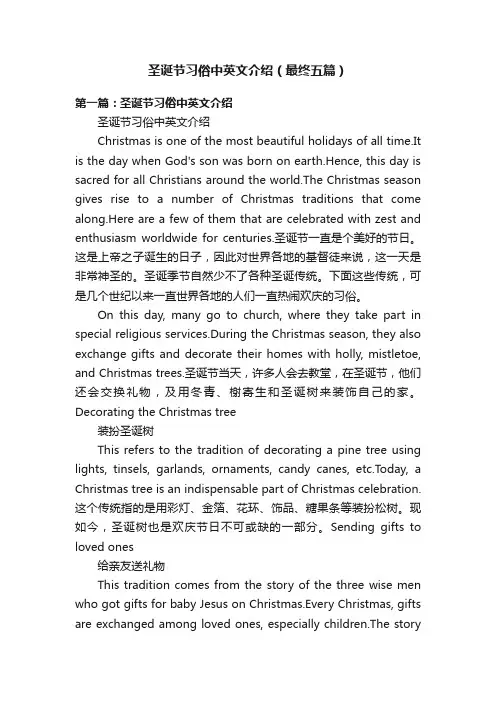
圣诞节习俗中英文介绍(最终五篇)第一篇:圣诞节习俗中英文介绍圣诞节习俗中英文介绍Christmas is one of the most beautiful holidays of all time.It is the day when God's son was born on earth.Hence, this day is sacred for all Christians around the world.The Christmas season gives rise to a number of Christmas traditions that come along.Here are a few of them that are celebrated with zest and enthusiasm worldwide for centuries.圣诞节一直是个美好的节日。
这是上帝之子诞生的日子,因此对世界各地的基督徒来说,这一天是非常神圣的。
圣诞季节自然少不了各种圣诞传统。
下面这些传统,可是几个世纪以来一直世界各地的人们一直热闹欢庆的习俗。
On this day, many go to church, where they take part in special religious services.During the Christmas season, they also exchange gifts and decorate their homes with holly, mistletoe, and Christmas trees.圣诞节当天,许多人会去教堂,在圣诞节,他们还会交换礼物,及用冬青、榭寄生和圣诞树来装饰自己的家。
Decorating the Christmas tree装扮圣诞树This refers to the tradition of decorating a pine tree using lights, tinsels, garlands, ornaments, candy canes, etc.T oday, a Christmas tree is an indispensable part of Christmas celebration.这个传统指的是用彩灯、金箔、花环、饰品、糖果条等装扮松树。
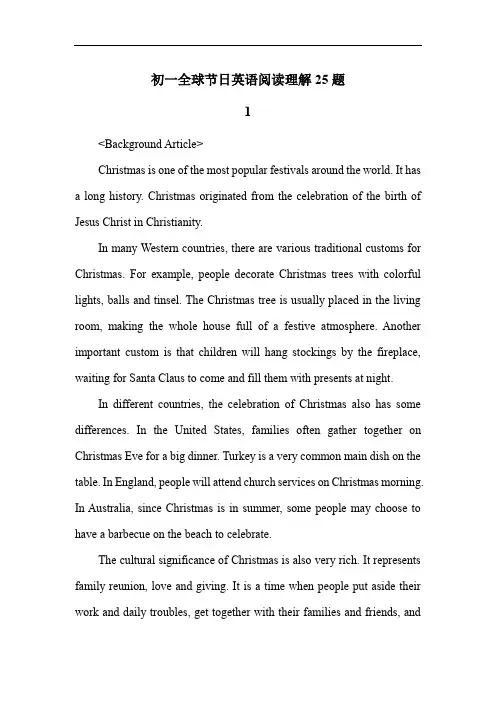
初一全球节日英语阅读理解25题1<Background Article>Christmas is one of the most popular festivals around the world. It has a long history. Christmas originated from the celebration of the birth of Jesus Christ in Christianity.In many Western countries, there are various traditional customs for Christmas. For example, people decorate Christmas trees with colorful lights, balls and tinsel. The Christmas tree is usually placed in the living room, making the whole house full of a festive atmosphere. Another important custom is that children will hang stockings by the fireplace, waiting for Santa Claus to come and fill them with presents at night.In different countries, the celebration of Christmas also has some differences. In the United States, families often gather together on Christmas Eve for a big dinner. Turkey is a very common main dish on the table. In England, people will attend church services on Christmas morning. In Australia, since Christmas is in summer, some people may choose to have a barbecue on the beach to celebrate.The cultural significance of Christmas is also very rich. It represents family reunion, love and giving. It is a time when people put aside their work and daily troubles, get together with their families and friends, andshare the joy of the festival. It also spreads the spirit of kindness and generosity, as people often donate to charities during this period.1. What is the origin of Christmas?A. It is to celebrate the new year.B. It comes from the celebration of the birth of Jesus Christ in Christianity.C. It is to celebrate the harvest.D. It is to celebrate the victory in the war.Answer: B. 解析:文章明确提到“Christmas originated from the celebration of the birth of Jesus Christ in Christianity.”,所以答案是B,A选项新年不是圣诞节的起源,C选项庆祝丰收也不符合,D选项庆祝战争胜利也不对。
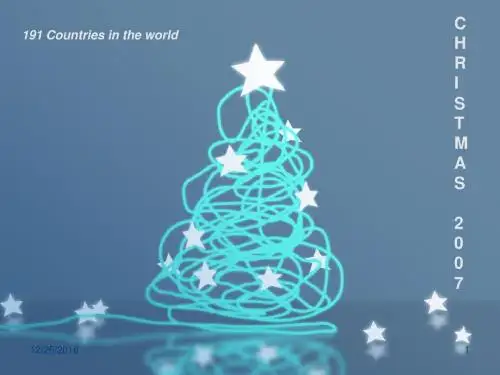
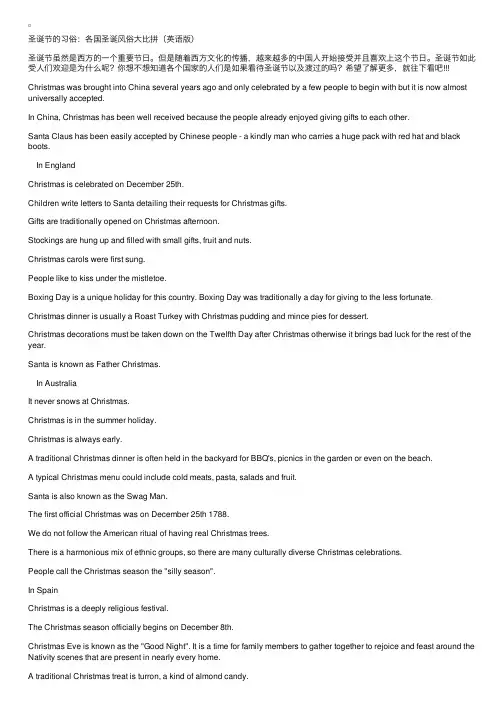
圣诞节的习俗:各国圣诞风俗⼤⽐拼(英语版)圣诞节虽然是西⽅的⼀个重要节⽇。
但是随着西⽅⽂化的传播,越来越多的中国⼈开始接受并且喜欢上这个节⽇。
圣诞节如此受⼈们欢迎是为什么呢?你想不想知道各个国家的⼈们是如果看待圣诞节以及渡过的吗?希望了解更多,就往下看吧Christmas was brought into China several years ago and only celebrated by a few people to begin with but it is now almost universally accepted.In China, Christmas has been well received because the people already enjoyed giving gifts to each other.Santa Claus has been easily accepted by Chinese people - a kindly man who carries a huge pack with red hat and black boots. In EnglandChristmas is celebrated on December 25th.Children write letters to Santa detailing their requests for Christmas gifts.Gifts are traditionally opened on Christmas afternoon.Stockings are hung up and filled with small gifts, fruit and nuts.Christmas carols were first sung.People like to kiss under the mistletoe.Boxing Day is a unique holiday for this country. Boxing Day was traditionally a day for giving to the less fortunate. Christmas dinner is usually a Roast Turkey with Christmas pudding and mince pies for dessert.Christmas decorations must be taken down on the Twelfth Day after Christmas otherwise it brings bad luck for the rest of the year.Santa is known as Father Christmas. In AustraliaIt never snows at Christmas.Christmas is in the summer holiday.Christmas is always early.A traditional Christmas dinner is often held in the backyard for BBQ's, picnics in the garden or even on the beach.A typical Christmas menu could include cold meats, pasta, salads and fruit.Santa is also known as the Swag Man.The first official Christmas was on December 25th 1788.We do not follow the American ritual of having real Christmas trees.There is a harmonious mix of ethnic groups, so there are many culturally diverse Christmas celebrations.People call the Christmas season the "silly season".In SpainChristmas is a deeply religious festival.The Christmas season officially begins on December 8th.Christmas Eve is known as the "Good Night". It is a time for family members to gather together to rejoice and feast around the Nativity scenes that are present in nearly every home.A traditional Christmas treat is turron, a kind of almond candy.December 28 is the feast of the Holy Innocents. Young boys of a town or village light bonfires and one of them acts as the mayor who orders townspeople to perform civic chores such as sweeping the streets.Refusal to comply results in fines which are used to pay for the celebration.Children receive gifts on January 6th - the feast of the Epiphany.Children leave their shoes on the windowsills and fill them with straw, carrots, and barley for the horses of the Wise Men. Their children's favorite Wise Man is Balthazar who rides a donkey and is the one believed to leave the gifts.People say "Feliz Navidad" for Merry Christmas.Santa Claus is called Papa Noel and some children will also receive presents from him on December 24th.In RussiaSt. Nicholas is extremely popular.St.Nicholas is also known as Grandfather Frost.New Year Day is the main holiday.Father Frost delivers presents on New Years Eve.Traditionally a figure called Babushka gave gifts to the children. Babushka is an old woman or grandmother with a headscarf tied under the chin.Christmas is celebrated on January 7th.Christmas day begins at midnight with churches ringing in the day with magnificent choral chanting.Christmas Eve dinner does not contain any meat.People eat a special porridge called "Kutya." This is made of wheat berries or other grains, which symbolize hope and immortality, and honey and poppy seeds, which ensure happiness, success, and untroubled rest.A ceremony involving the blessing of the home is frequently observed. A priest visits the home accompanied by boys carrying vessels of holy water, and a little water is sprinkled in each room.In GermanyThey hold special markets every December that specialize in selling decorations and other Christmas related paraphernalia. The people make and drink a spiced wine, which is called "mulled wine" in English and "Gluhwein" in their own language. One of the famous traditional Christmas toys is the Nutcracker doll that now comes in many different styles.The "Advent Calendar" originated here and is now used by children in many other countries that celebrate Christmas.The Advent Calendar is used for counting down the days to Christmas and has twenty-four little doors with a picture and sometimes chocolate behind each one.Children leave out a sock on December 6th for Saint Nicholas to fill with candies.Families gather together on Christmas Eve to open their presents.A traditional cake is eaten at Christmas time, called "Stollen" cake. It is very rich, fruity and coated with marzipan and icing sugar.The Christmas tree originated.At Christmas time if you been a bad boy or girl you will be visited by the evil Hans Muff and receive nothing.In FranceEvery home displays a nativity scene featuring little clay figurines made in the south of this country.The Christmas tree has never been popular here.In many areas children receive gifts from Pere Noel.They receive gifts on both December 6th and Christmas Day.In other regions the gifts are delivered by "Le petit Jesus".There is a traditional grand feast every year held after midnight mass on Christmas Eve.A world famous cake is baked for the Christmas season in the shape of a log, usually coated in chocolate and extremely delicious.One part of the country celebrates Christmas by eating turkey and chestnuts.The capital city celebrates by eating oysters.Adults wait until New Years Day to exchange gifts.。
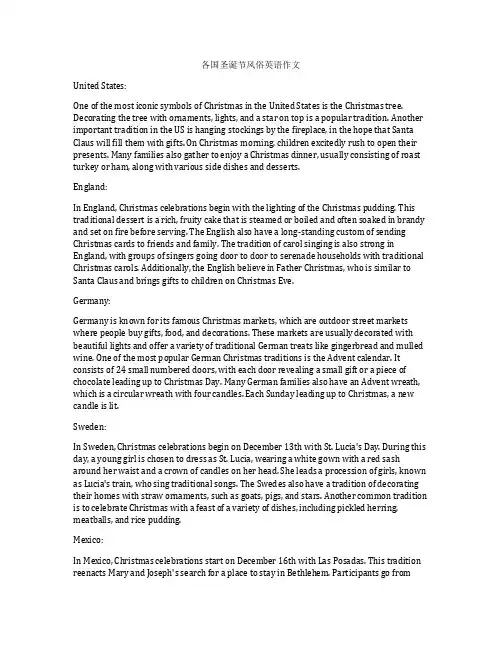
各国圣诞节风俗英语作文United States:One of the most iconic symbols of Christmas in the United States is the Christmas tree. Decorating the tree with ornaments, lights, and a star on top is a popular tradition. Another important tradition in the US is hanging stockings by the fireplace, in the hope that Santa Claus will fill them with gifts. On Christmas morning, children excitedly rush to open their presents. Many families also gather to enjoy a Christmas dinner, usually consisting of roast turkey or ham, along with various side dishes and desserts.England:In England, Christmas celebrations begin with the lighting of the Christmas pudding. This traditional dessert is a rich, fruity cake that is steamed or boiled and often soaked in brandy and set on fire before serving. The English also have a long-standing custom of sending Christmas cards to friends and family. The tradition of carol singing is also strong in England, with groups of singers going door to door to serenade households with traditional Christmas carols. Additionally, the English believe in Father Christmas, who is similar to Santa Claus and brings gifts to children on Christmas Eve.Germany:Germany is known for its famous Christmas markets, which are outdoor street markets where people buy gifts, food, and decorations. These markets are usually decorated with beautiful lights and offer a variety of traditional German treats like gingerbread and mulled wine. One of the most popular German Christmas traditions is the Advent calendar. It consists of 24 small numbered doors, with each door revealing a small gift or a piece of chocolate leading up to Christmas Day. Many German families also have an Advent wreath, which is a circular wreath with four candles. Each Sunday leading up to Christmas, a new candle is lit.Sweden:In Sweden, Christmas celebrations begin on December 13th with St. Lucia's Day. During this day, a young girl is chosen to dress as St. Lucia, wearing a white gown with a red sash around her waist and a crown of candles on her head. She leads a procession of girls, known as Lucia's train, who sing traditional songs. The Swedes also have a tradition of decorating their homes with straw ornaments, such as goats, pigs, and stars. Another common tradition is to celebrate Christmas with a feast of a variety of dishes, including pickled herring, meatballs, and rice pudding.Mexico:In Mexico, Christmas celebrations start on December 16th with Las Posadas. This tradition reenacts Mary and Joseph's search for a place to stay in Bethlehem. Participants go fromhouse to house, singing carols and asking for shelter until they are finally welcomed in. Another important part of Christmas in Mexico is the Nativity scene or Nacimiento, which depicts the birth of Jesus. It is often displayed in homes and churches and includes figures of Mary, Joseph, baby Jesus, the Three Wise Men, and other characters. On Christmas Eve, many Mexicans attend a midnight Mass called La Misa del Gallo, followed by a festive meal.Japan:Christmas is not traditionally a religious holiday in Japan, but it has become a popular occasion to exchange gifts and spend time with loved ones. One of the most unusual Christmas traditions in Japan is the tradition of eating fried chicken on Christmas Eve. Many Japanese people pre-order their KFC meals months in advance to avoid the long lines during the holiday season. The streets are also decorated with lights and decorations, and people often give Christmas cards and gifts to friends and colleagues.These are just a few examples of the diverse Christmas customs practiced around the world. Each country puts its own unique twist on this festive holiday, making it a special time of celebration and joy for people of all cultures and backgrounds.。
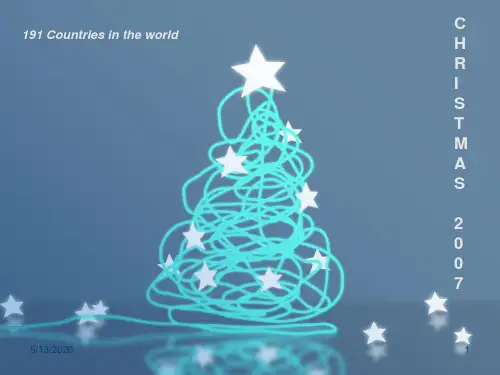
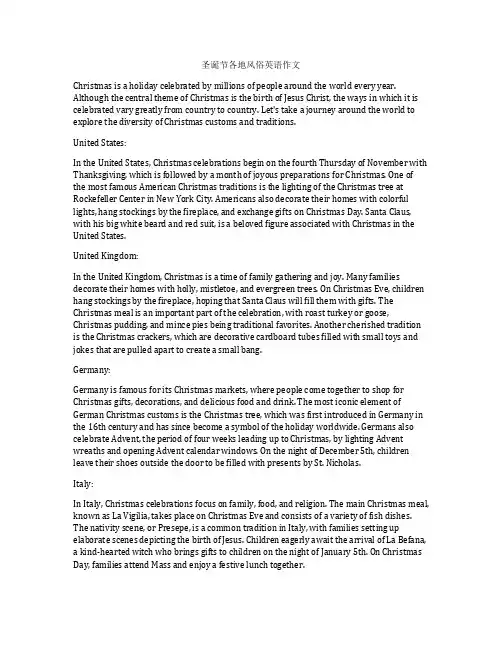
圣诞节各地风俗英语作文Christmas is a holiday celebrated by millions of people around the world every year. Although the central theme of Christmas is the birth of Jesus Christ, the ways in which it is celebrated vary greatly from country to country. Let's take a journey around the world to explore the diversity of Christmas customs and traditions.United States:In the United States, Christmas celebrations begin on the fourth Thursday of November with Thanksgiving, which is followed by a month of joyous preparations for Christmas. One of the most famous American Christmas traditions is the lighting of the Christmas tree at Rockefeller Center in New York City. Americans also decorate their homes with colorful lights, hang stockings by the fireplace, and exchange gifts on Christmas Day. Santa Claus, with his big white beard and red suit, is a beloved figure associated with Christmas in the United States.United Kingdom:In the United Kingdom, Christmas is a time of family gathering and joy. Many families decorate their homes with holly, mistletoe, and evergreen trees. On Christmas Eve, children hang stockings by the fireplace, hoping that Santa Claus will fill them with gifts. The Christmas meal is an important part of the celebration, with roast turkey or goose, Christmas pudding, and mince pies being traditional favorites. Another cherished tradition is the Christmas crackers, which are decorative cardboard tubes filled with small toys and jokes that are pulled apart to create a small bang.Germany:Germany is famous for its Christmas markets, where people come together to shop for Christmas gifts, decorations, and delicious food and drink. The most iconic element of German Christmas customs is the Christmas tree, which was first introduced in Germany in the 16th century and has since become a symbol of the holiday worldwide. Germans also celebrate Advent, the period of four weeks leading up to Christmas, by lighting Advent wreaths and opening Advent calendar windows. On the night of December 5th, children leave their shoes outside the door to be filled with presents by St. Nicholas.Italy:In Italy, Christmas celebrations focus on family, food, and religion. The main Christmas meal, known as La Vigilia, takes place on Christmas Eve and consists of a variety of fish dishes. The nativity scene, or Presepe, is a common tradition in Italy, with families setting up elaborate scenes depicting the birth of Jesus. Children eagerly await the arrival of La Befana, a kind-hearted witch who brings gifts to children on the night of January 5th. On Christmas Day, families attend Mass and enjoy a festive lunch together.Mexico:In Mexico, Christmas celebrations last for nine days, starting on December 16th and ending on Christmas Eve with the midnight Mass known as Misa de Gallo. This period is called Las Posadas and represents the journey of Mary and Joseph as they looked for a place to stay in Bethlehem. Each evening, a procession reenacts the journey, with participants carrying candles and singing Christmas carols. Traditional Mexican foods, such as tamales and ponche, a warm fruit punch, are enjoyed during this festive season. Children receive gifts on January 6th, known as Epiphany or Dia de los Reyes.Australia:Christmas in Australia falls during the summer, which means that people often celebrate with outdoor activities such as barbecues, beach trips, and picnics. Australians decorate their homes with wreaths, lights, and ornaments, but instead of snow-covered scenes, they often create beach-themed decorations. Australians also have their own version of Santa Claus, known as Santa Claus, or Father Christmas, who wears a red bathing suit and travels on a surfboard pulled by kangaroos.These are just a few examples of the diverse Christmas customs around the world. Whether it's the sparkling lights in New York City or the warm summer breeze in Australia, the spirit of Christmas unites people in celebration, joy, and love. Regardless of the specific traditions, the message of Christmas remains the same – to spread goodwill and peace to all.。
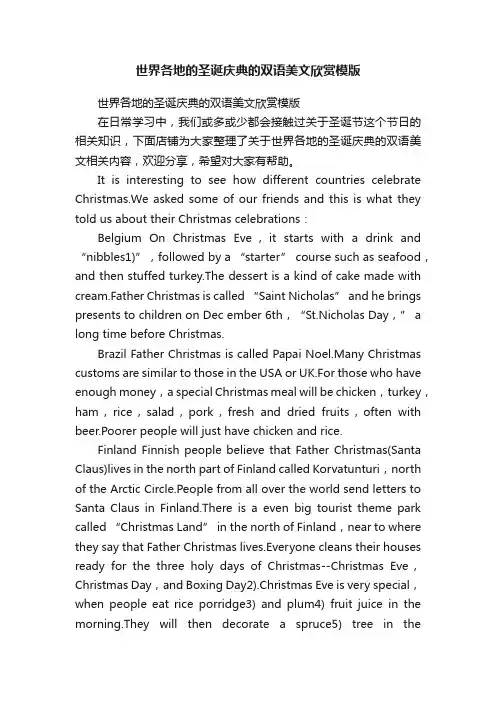
世界各地的圣诞庆典的双语美文欣赏模版世界各地的圣诞庆典的双语美文欣赏模版在日常学习中,我们或多或少都会接触过关于圣诞节这个节日的相关知识,下面店铺为大家整理了关于世界各地的圣诞庆典的双语美文相关内容,欢迎分享,希望对大家有帮助。
It is interesting to see how different countries celebrate Christmas.We asked some of our friends and this is what they told us about their Christmas celebrations:Belgium On Christmas Eve,it starts with a drink and “nibbles1)”,followed by a “starter” course such as seafood,and then stuffed turkey.The dessert is a kind of cake made with cream.Father Christmas is called “Saint Nicholas” and he brings presents to children on Dec ember 6th,“St.Nicholas Day,” a long time before Christmas.Brazil Father Christmas is called Papai Noel.Many Christmas customs are similar to those in the USA or UK.For those who have enough money,a special Christmas meal will be chicken,turkey,ham,rice,salad,pork,fresh and dried fruits,often with beer.Poorer people will just have chicken and rice.Finland Finnish people believe that Father Christmas(Santa Claus)lives in the north part of Finland called Korvatunturi,north of the Arctic Circle.People from all over the world send letters to Santa Claus in Finland.There is a even big tourist theme park called “Christmas Land” in the north of Finla nd,near to where they say that Father Christmas lives.Everyone cleans their houses ready for the three holy days of Christmas--Christmas Eve,Christmas Day,and Boxing Day2).Christmas Eve is very special,when people eat rice porridge3) and plum4) fruit juice in the morning.They will then decorate a spruce5) tree in thehome.Many families will visit cemeteries and graveyards to place a candle onto the burial graves of family members.Cemeteries are very beautiful at Christmas-time.France In France,everyone has a Christmas tree,sometimes decorated in the old way with red ribbons and real white wax candles.Fir6) trees in the garden are often decorated too,with lights on all night.Father Christmas is called Père Noel.The Christmas meal is an important family gathering with good meat and the best wine.Not everyone sends Christma as cards.Germany Germans love to decoratetheir house sat Christmas.Many houses will have little wooden frames holding electric candles in their windows,and coloured pictures of paper or plastic which look beautiful from the outside at night.Father Christmas brings presents in the late afternoon of Christmas Eve(December 24th),after people have been to a church meeting.The presents are then found under the Christmas tree.One person in the family will ring a bell and call everyone to come to the room.On Christmas Day,fish(carp7))or goose will be cooked.Latvia Latvians believe that Father Christmas brings presents on each of the 12days of Christmas starting on Christmas ually the presents are put under the family Christmas tree.The special Latvian Christmas Day meal is cooked brown peas with bacon(pork)sauce,small pies,cabbage and sausage.Portugal People pretend that Father Christmas brings presents to children on Christmas Eve.The presents are left under the Christmas tree or in shoes by the fireplace.A special Christmas meal of salted dry cod-fish8) with boiled potatoes is eaten at midnight on Christmas Eve.Russia In the days of the Soviet Union,Christmas was not celebrated very much.New Year was the important time--when “Father Frost” brought presents to children.Now Christmas can be openly celebrated--either on December25th;or more often on January 7th.This unusual date is because the Russian Orthodox church uses the old“Julian”calenda r9) for religious celebration days.Special Christmas food includes cakes,pies and “meat dumplings.”Sweden The most important day is Christmas Eve.A special Christmas meal is eaten on Christmas Eve--ham(pork),herring10) fish,and brown beans--and this is the time when families give presents to each other.Many people attend a church meeting early on Christmas Day.了解不同的国家怎样庆祝圣诞节是一件有趣的事情。
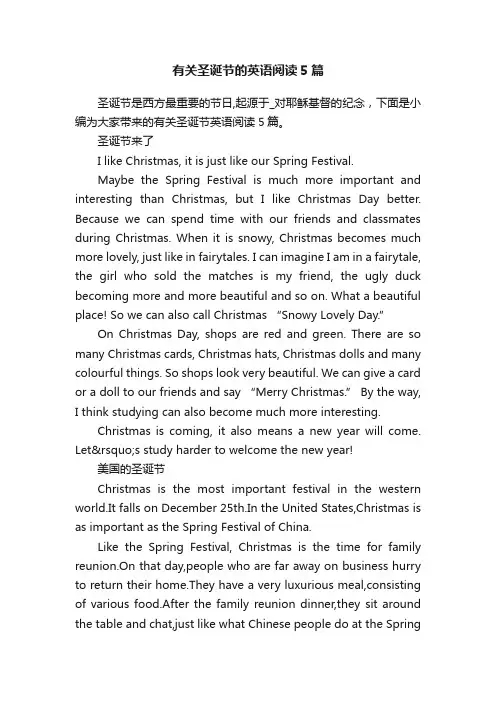
有关圣诞节的英语阅读5篇圣诞节是西方最重要的节日,起源于_对耶稣基督的纪念,下面是小编为大家带来的有关圣诞节英语阅读5篇。
圣诞节来了I like Christmas, it is just like our Spring Festival.Maybe the Spring Festival is much more important and interesting than Christmas, but I like Christmas Day better. Because we can spend time with our friends and classmates during Christmas. When it is snowy, Christmas becomes much more lovely, just like in fairytales. I can imagine I am in a fairytale, the girl who sold the matches is my friend, the ugly duck becoming more and more beautiful and so on. What a beautiful place! So we can also call Christmas “Snowy Lovely Day.”On Christmas Day, shops are red and green. There are so many Christmas cards, Christmas hats, Christmas dolls and many colourful things. So shops look very beautiful. We can give a card or a doll to our friends and say “Merry Christmas.” By the way, I think studying can also become much more interesting.Christmas is coming, it also means a new year will come. Let’s study harder to welcome the new year!美国的圣诞节Christmas is the most important festival in the western world.It falls on December 25th.In the United States,Christmas is as important as the Spring Festival of China.Like the Spring Festival, Christmas is the time for family reunion.On that day,people who are far away on business hurry to return their home.They have a very luxurious meal,consisting of various food.After the family reunion dinner,they sit around the table and chat,just like what Chinese people do at the SpringFestival.Christmas is the time for exchanging presents.Generally,American take two weeks to prepare lots of Christmas presents to celebrate it.On this holiday,gifts are exchanged among friends and family members.In addition,children are likely to get some gifts attributed to Santa Claus.Christmas is the time for American to get away from their busy lives and have some fun.T o celebrate the holiday,they decorate their Christmas trees,windows and gardens with colorful lights.When the lights shine brightly everywhere at night,it seems almost like daytime. Nowadays,Christmas culture has become a part of American culture, moreover,American Christmas traditions will be also still practiced.圣诞日Christmas Day falls on the twenty-fifth of December. It is a very happy day for many boys and girls. Before the term ends in some schools, the children act a nativity or “birth” play, showing how Jesus was born in a stable.On the twenty-fourth of December, all children are very excited. Usually they are sent to bed early so that their parents can get the presents ready. The younger children think that Father Christmas will come down the chimney or fireplace, so they hang up a sock for him to put presents in. The greedy ones even hang up a pillow-case or a sack to try to get more presents. Later that night, father or mother will put presents in the sock, and leave others at the side of the bed.On Christmas morning, the children wake up very early. Some even turn on the light at two o'clock, and most of them are awake by six o'clock, and the young ones play while the dinner isprepared. At about one o'clock in the afternoon, the Christmas dinner is brought in. The turkey or chicken is quickly eaten. Children search in their Christmas pudding for new coins which are hidden in it. The rest of the day is full of games and eating until the happiest of all Christmas holidays comes to an end.Christmas Day圣诞节Christmas Day falls on the twenty-fifth of December. It is a very happy day for many boys and girls. Before the term ends in some schools, the children act a nativity or “birth” play, showing how Jesus was born in a stable.12月25日是圣诞节。
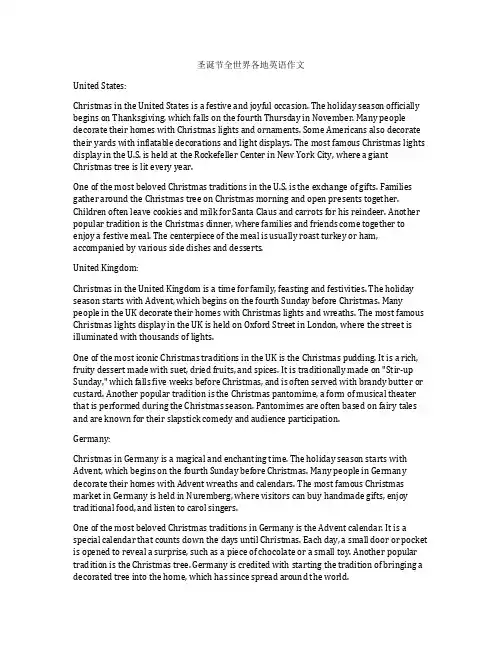
圣诞节全世界各地英语作文United States:Christmas in the United States is a festive and joyful occasion. The holiday season officially begins on Thanksgiving, which falls on the fourth Thursday in November. Many people decorate their homes with Christmas lights and ornaments. Some Americans also decorate their yards with inflatable decorations and light displays. The most famous Christmas lights display in the U.S. is held at the Rockefeller Center in New York City, where a giant Christmas tree is lit every year.One of the most beloved Christmas traditions in the U.S. is the exchange of gifts. Families gather around the Christmas tree on Christmas morning and open presents together. Children often leave cookies and milk for Santa Claus and carrots for his reindeer. Another popular tradition is the Christmas dinner, where families and friends come together to enjoy a festive meal. The centerpiece of the meal is usually roast turkey or ham, accompanied by various side dishes and desserts.United Kingdom:Christmas in the United Kingdom is a time for family, feasting and festivities. The holiday season starts with Advent, which begins on the fourth Sunday before Christmas. Many people in the UK decorate their homes with Christmas lights and wreaths. The most famous Christmas lights display in the UK is held on Oxford Street in London, where the street is illuminated with thousands of lights.One of the most iconic Christmas traditions in the UK is the Christmas pudding. It is a rich, fruity dessert made with suet, dried fruits, and spices. It is traditionally made on "Stir-up Sunday," which falls five weeks before Christmas, and is often served with brandy butter or custard. Another popular tradition is the Christmas pantomime, a form of musical theater that is performed during the Christmas season. Pantomimes are often based on fairy tales and are known for their slapstick comedy and audience participation.Germany:Christmas in Germany is a magical and enchanting time. The holiday season starts with Advent, which begins on the fourth Sunday before Christmas. Many people in Germany decorate their homes with Advent wreaths and calendars. The most famous Christmas market in Germany is held in Nuremberg, where visitors can buy handmade gifts, enjoy traditional food, and listen to carol singers.One of the most beloved Christmas traditions in Germany is the Advent calendar. It is a special calendar that counts down the days until Christmas. Each day, a small door or pocket is opened to reveal a surprise, such as a piece of chocolate or a small toy. Another popular tradition is the Christmas tree. Germany is credited with starting the tradition of bringing a decorated tree into the home, which has since spread around the world.Japan:Christmas is not a national holiday in Japan, but it has become a popular and widely celebrated occasion. In Japan, Christmas is seen as a time for couples to spend together and exchange gifts. Many people in Japan also decorate their homes with Christmas lights and ornaments. The most famous Christmas lights display in Japan is held at the Tokyo Midtown, where the trees are illuminated with thousands of lights.One of the most unique Christmas traditions in Japan is the eating of fried chicken. It is a popular tradition to order KFC (Kentucky Fried Chicken) for Christmas dinner, as KFC launched a successful marketing campaign in the 1970s promoting fried chicken as a Christmas meal. Another popular tradition is the Christmas cake, which is a sponge cake decorated with strawberries and whipped cream.Australia:Christmas in Australia is quite different from the traditional snowy Christmas in the northern hemisphere. As Christmas falls in the summer season in Australia, many people celebrate Christmas outdoors. It is common to have a barbeque on the beach or in the backyard, where families and friends gather to enjoy a festive meal. Many Australians also decorate their homes with Christmas lights and ornaments. The most famous Christmas lights display in Australia is held at the Sydney Opera House, where the iconic building is illuminated with colorful lights.One of the most beloved Christmas traditions in Australia is Santa Claus arriving on a surfboard. This reflects the beach culture of the country, as Santa Claus is often depicted wearing a swimsuit and sunglasses. Another popular tradition is the singing of Christmas carols. Many towns and cities in Australia have outdoor carol concerts, where people gather to sing traditional carols and enjoy the festive atmosphere.In conclusion, Christmas is a special time of the year when people all over the world come together to celebrate and spread joy and love. Although the way Christmas is celebrated may vary from country to country, the spirit of the holiday remains the same. Whether it is exchanging gifts, enjoying festive meals, or participating in unique traditions, Christmas brings people together and reminds us of the importance of family and love.。
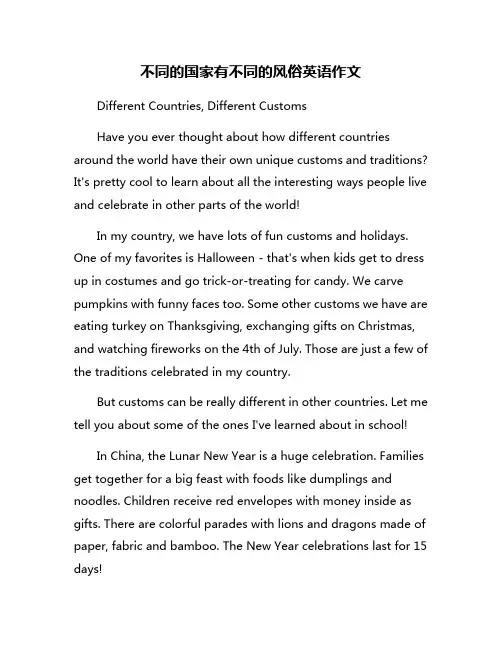
不同的国家有不同的风俗英语作文Different Countries, Different CustomsHave you ever thought about how different countries around the world have their own unique customs and traditions? It's pretty cool to learn about all the interesting ways people live and celebrate in other parts of the world!In my country, we have lots of fun customs and holidays. One of my favorites is Halloween - that's when kids get to dress up in costumes and go trick-or-treating for candy. We carve pumpkins with funny faces too. Some other customs we have are eating turkey on Thanksgiving, exchanging gifts on Christmas, and watching fireworks on the 4th of July. Those are just a few of the traditions celebrated in my country.But customs can be really different in other countries. Let me tell you about some of the ones I've learned about in school!In China, the Lunar New Year is a huge celebration. Families get together for a big feast with foods like dumplings and noodles. Children receive red envelopes with money inside as gifts. There are colorful parades with lions and dragons made of paper, fabric and bamboo. The New Year celebrations last for 15 days!In India, there is a festival of colors called Holi that looks like a lot of fun. People have parties where they throw bright colored powders and get covered from head to toe. The colorful powder represents energy, life and joy. There is also a lot of singing, dancing and enjoying sweet treats during Holi.In Mexico, one of the biggest celebrations is Dia De Los Muertos or Day of the Dead. Instead of being a sad occasion, this is a joyful time to remember loved ones who have passed away. Families create beautiful altars with marigold flowers, candles, and their loved one's favorite foods and items. There are also huge parade celebrations with music, dancing and colorful skull masks.In Sweden, kids get excited for Christmas a little differently than here. Instead of leaving cookies for Santa, they leave out a bowl of rice pudding for a tiny elf-like creature called a Tomte. The Tomte is supposed to take care of a family's farm animals and household. If you forget to leave the rice pudding out, the Tomte might play tricks on you!In Brazil, the biggest party of the year is Carnival! This wild celebration features huge parades with dancers wearing sparkly costumes and feathery headdresses. People dance in the streets to the sound of loud drums and music for days before the startof Lent. There are also fun neighborhood parties with everyone dancing the samba.Japan has a very interesting festival called Omizutori where people get to experience a type of ritual purification. They go to a shrine and catch ladles of water that Shinto priests have poured over a sacred object. After catching the water, people drink or pour it over themselves to become purified and washed clean of any bad luck from the previous year.Those are just a few examples of the many unique customs celebrated all over the world. Every country has their own special traditions passed down through generations. Some customs are religious, while others are just for fun. Many customs bring people together to celebrate things like the New Year, harvest seasons, or important historical events.No matter what country you're from or what customs your family celebrates, traditions help bring people closer to their culture and communities. They allow us to learn about our ancestors and make wonderful memories with our loved ones year after year. Customs may be different around the world, but they all serve as a way for people to honor their heritage and values.I think it's really cool to learn about all the diverse customs in other countries. Understanding different cultural traditions helps kids like me appreciate how people can share the world in such wonderfully unique ways. I hope you enjoyed learning a little bit about a few customs from around the globe. The world is full of so many amazing traditions - I can't wait to discover more!。
国外圣诞节的文化风俗英文作文英文回答:Christmas is one of the most important holidays in many countries around the world. It is a time for families to come together and celebrate the birth of Jesus Christ.There are many cultural customs and traditions associated with Christmas, and I will discuss some of them below.One popular tradition during Christmas is the exchangeof gifts. People buy presents for their loved ones and friends, and they are usually placed under a Christmas tree. On Christmas morning, children wake up excitedly to findthe gifts that Santa Claus has left for them. Thistradition is known as "Santa Claus bringing gifts" and it symbolizes the spirit of giving and generosity.Another important aspect of Christmas is the decoration of homes and streets. Many people decorate their houseswith colorful lights, wreaths, and ornaments. In somecountries, like the United States, it is common to see houses covered in lights and decorations. This tradition is called "decking the halls" and it adds a festive and joyful atmosphere to the holiday season.Christmas is also a time for delicious food and feasting. Families gather together to enjoy a special meal, which often includes traditional dishes like roast turkey, ham, and Christmas pudding. In some cultures, it is customary to have a big feast on Christmas Eve, known as "Christmas Eve dinner". This is a time for families to bond and share a meal together.Another tradition that is popular during Christmas is the singing of Christmas carols. People go from door to door, singing songs and spreading holiday cheer. This tradition is known as "caroling" and it brings joy and happiness to both the singers and the listeners.In addition to these customs, there are also religious ceremonies and services that take place during Christmas. Many people attend midnight Mass or church services tocelebrate the birth of Jesus Christ. These services areoften filled with beautiful music and prayers.Overall, Christmas is a time of joy, love, and togetherness. It is a time to celebrate with family and friends, exchange gifts, decorate homes, enjoy delicious food, sing carols, and attend religious services. It is a holiday that brings people together and spreads happiness and goodwill.中文回答:圣诞节是世界上许多国家最重要的节日之一。
圣诞节传统与习俗英语作文Christmas is a widely celebrated holiday around the world, filled with traditions and customs that have been passed down from generation to generation. It is a time of joy, love, and giving. In this essay, we will explore the various Christmas traditions and customs observed in different countries and cultures.One of the most popular traditions associated with Christmas is the decorating of a Christmas tree. This tradition is believed to have originated in Germany in the 16th century and has since spread to many other countries. Typically, families gather around the tree and decorate it with ornaments, lights, and tinsel. In some countries, such as the United States, it is common to top the tree with a star or an angel. The Christmas tree is often the centerpiece of the holiday decorations and brings a festive atmosphere to the home. Another beloved tradition is the exchange of gifts. This tradition has its roots in the story of the three wise men who brought gifts to the baby Jesus. Today, family and friends exchange gifts as a way to show love and appreciation. In many countries, children are especially excited about receiving presents from Santa Claus. They write letters to Santa, detailing their wish lists and eagerly await his arrival on Christmas Eve. The exchange of gifts is often done on Christmas morning, with family members taking turns opening presents and expressing gratitude.In addition to the Christmas tree and gift exchange, there are many other customs that vary from country to country. For example, in Italy, it is common to celebrate the Feast of Seven Fishes on Christmas Eve. This involves preparing a meal of seven different types of seafood dishes. In Sweden, families celebrate with the tradition of St. Lucia's Day on December 13th. Young girls dress up in white robes with a red sash and a crown of candles on their heads. They sing songs and bring treats to family and friends.Another fascinating tradition takes place in Catalonia, Spain. It is called the Tió de Nadal or Christmas Log. A wooden log is decorated with a face and covered with a blanket. From December 8th until Christmas Eve, children feed the log every night with fruits, nuts, and sweets. On Christmas Eve, the children beat the log with sticks while singing traditional songs, encouraging it to "poop" out the treats hidden inside.In many Latin American countries, people celebrate "Las Posadas," a reenactment of Mary and Joseph's search for a place to stay in Bethlehem. A procession of people, carrying images of Mary and Joseph, go from house to house, seeking shelter. They are turned away until they reach the designated home where the doors are opened to them. This tradition is followed by a feast, dancing, and piñatas filled with sweets for the children.In the Philippines, Christmas is celebrated with a range of unique customs. One such custom is the Simbang Gabi or the Misa de Gallo. This is a series of early morning masses held from December 16th to Christmas Eve. The masses are attended by devout Catholics who believe that if they complete the nine-day Novena, their prayers will be granted. After the mass,people gather outside to enjoy traditional Filipino delicacies such as bibingka and puto bumbong.These are just a few examples of the diverse and colorful Christmas traditions and customs around the world. Each country and culture has its own unique way of celebrating the holiday season. However, the underlying theme of love, togetherness, and generosity can be felt throughout the world. It is a time to cherish our loved ones, reflect on the past year, and look forward to a new beginning. Christmas traditions and customs bring people together and create lasting memories that are treasured for generations to come.。
圣诞节的不同英语作文80词In the United States, Christmas is commonly celebrated with a variety of traditions. One of the most iconic is the decoration of Christmas trees. Families gather around to adorn the tree with ornaments, lights, and a star or angel on top. Gifts are placed under the tree and are opened on the morning of December 25th. Another popular tradition is hanging stockings by the fireplace. Children believe that Santa Claus will fill their stockings with gifts if they have been good throughout the year. Additionally, many families attend religious services on Christmas Eve and then enjoy a festive meal together on Christmas Day.In the United Kingdom, Christmas is a time for great feasting and merriment. Traditional Christmas dishes include roast turkey, Christmas pudding, and mince pies. It is also common for families to pull Christmas crackers, which are small paper tubes that contain a paper hat, a joke, and a small toy. The crackers are pulled apart with a snapping action, and the person who has the larger part of the cracker gets to keep the contents. The Queen's Christmas message is also an important tradition in the UK. Every year, Queen Elizabeth II addresses the nation with a televised speech, reflecting on the year and the importance of Christmas.In Germany, Christmas is celebrated with festive markets called Weihnachtsmärkte. These markets are filled with stalls selling Christmas decorations, crafts, and delicious food and drinks. It is a popular tradition to visit these markets with family and friends to enjoy the festive atmosphere. Advent calendars are also widely used in Germany. These calendars have 24 small doors, and each day leading up to Christmas, a door is opened to reveal a small treat or gift. On Christmas Eve, families gather for a festive dinner, exchange gifts, and attend midnight Mass.In Sweden, Christmas is celebrated over several days. The celebration begins on December 13th with St. Lucia's Day. In the early morning, the youngest daughter in the family dresses as St. Lucia, wearing a white gown with a red sash and a crown of candles on her head. She serves her family members coffee and special saffron buns called "lussekatter." On Christmas Eve, families gather to exchange gifts and enjoy a traditional meal of ham, herring, and potatoes. It is also common to dance around the Christmas tree and sing songs.In Australia, Christmas falls in the middle of summer, which means that many traditional Christmas activities take place outdoors. Families often have barbecues, picnics, or beach outings. It is also common to exchange gifts under the shade of a tree or by the pool. While Christmas trees are still popular, they are often decorated with ornaments made from seashells or other Australian symbols. In some regions, it is traditional to set up a "Christmas Bush" which is a native Australian shrub with red flowers that bloom in December.As we can see, Christmas is celebrated in diverse ways around the world. These unique traditions and customs contribute to the rich tapestry of the holiday season, making it a special and memorable time for people of all cultures and backgrounds. Whether it isdecorating a tree, feasting on delicious food, or exchanging gifts, the spirit of Christmas brings people together in a spirit of joy, love, and unity.。
圣诞节的地域风俗英文作文Let's start our journey in Europe, where many of the beloved Christmas traditions originated.In Germany, Christmas is a time of great joy and excitement. One of the most well-known customs is the Advent calendar. Starting from December 1st, children open one window of the calendar each day until Christmas Eve. Behind each window, there is a small gift or a sweet treat, building the anticipation and excitement for the big day. Another important tradition is the Christmas market. These markets are set up in towns and cities across the country, where people can buy handcrafted ornaments, enjoy delicious food and drinks, and experience the festive atmosphere.Moving on to Scandinavia, we find Denmark celebrating Christmas in a unique and hygge (a Danish word meaning cozy and comfortable) way. On Christmas Eve, families gather together to have a festive meal, which often includes roast duck, potatoes, and pickled red cabbage. After dinner, they dance around the Christmas tree while singing traditional carols. In Sweden, a key part of Christmas is the Lucia procession, which takes place on December 13th. A young girl, chosen to represent Santa Lucia, wears a wreath of candles on her head and leads a procession of singing children, bringing light and cheer to homes and hospitals. In the United Kingdom, Christmas is celebrated with great enthusiasm and many time-honored customs. One of the most famous traditions is hanging stockings by the fireplace on Christmas Eve. Children believe that Santa Claus will fill these stockings with small gifts, chocolates, and oranges if they have been good throughout the year. The Christmas pudding is a classic dessert served on Christmas Day. This rich and fruity pudding is often soaked in brandy and set alight before being served with a dollop of creamy custard.Moving across the Atlantic to North America, we find that Christmas traditions have been influenced by various cultures and traditions. In the United States, the tradition of sending Christmas cards is deeply rooted. It is a way for friends and family to keep in touch and share warm wishes during the holiday season. Another important tradition is the decoration of the Christmas tree. Families gather together to decorate the tree with ornaments, lights, and tinsel, creating a beautiful centerpiece for their homes.In Mexico, Christmas celebrations start on December 16th with the tradition of Posadas. Posadas reenact Mary and Joseph's search for a place to stay in Bethlehem. Each night, a procession goes from house to house, with participants dressed as Mary and Joseph. They are eventually welcomed into a house, where the celebration continues with music, food, and piñatas. On Christmas Eve, families gather for a late-night feast called Nochebuena, which includes traditional dishes such as bacalao (salted cod), tamales, and ponche (a warm fruit punch).In Australia, Christmas falls during the summer season, which means that some traditional Christmas elements are adapted to suit the climate. Instead of a hot roast dinner,Australians often celebrate with a barbecue or a seafood feast. Many families also head to the beach on Christmas Day to enjoy the sunshine and have a picnic. The iconic Christmas carol "Jingle Bells" was actually written in Australia, and it has become a symbol of the festive season Down Under.Lastly, let's explore Christmas customs in Asia, where the holiday is not widely celebrated but has gained popularity in recent years. In South Korea, Christmas is seen as a romantic holiday for couples. Many young couples exchange gifts, go on dates, and enjoy romantic dinners together. In Japan, although Christmas is not a national holiday, it is celebrated in a fun and festive way. Illuminated displays, called "illuminations," light up streets and parks, creating a magical atmosphere. Families often have a Christmas cake, which is usually a sponge cake decorated with whipped cream and strawberries.In conclusion, Christmas traditions vary greatly from region to region, but they all share a common goal: to bring people together and create a sense of joy and goodwill. Whether it's the Advent calendar in Germany, the Posadas in Mexico, or the illuminated displays in Japan, these customs and traditions make the holiday season a special time for people around the world. As we celebrate Christmas, let's embrace and appreciate the diversity of these regional customs, and may the spirit of Christmas bring warmth, happiness, and peace to all.。
圣诞节的地域风俗作文英文Let us begin our exploration in England, where Christmas traditions and customs have their roots in ancient pagan festivals. The English love to decorate their homes with holly, ivy, and mistletoe, and it is a common practice to hang Christmas stockings by the fireplace for Father Christmas to fill with gifts. The English also have a custom called "mumming," where people dress up in costumes and go from house to house, performing plays and songs in exchange for food and drink.In Scotland, Christmas is known as "Yule" and is celebrated with great fervor. One famous tradition in Scotland is the "First-footing," where the first person to enter a home after midnight on Christmas Eve is believed to bring good luck for the coming year. It is customary for this person to carry a gift, such as coal or whiskey, as a symbol of prosperity. Another unique Scottish tradition is the "Burning of the Clavie," where a barrel filled with tar and wood is set on fire and carried around the village to ward off evil spirits.Moving on to France, Christmas is a time for feasting and merriment. French families gather for a meal called "le Réveillon" on Christmas Eve, which typically consists of luxurious dishes such as foie gras, oysters, and roast turkey. In some regions of France, it is customary to leave out a plate of food and a glass of wine for Père Noël (Father Christmas) or his donkey. Another interesting French tradition is the "bûche de Noël" (Yule log), a cake shaped like a log that is served as dessert on Christmas Day.In Germany, Christmas is a magical time, filled with enchanting traditions. One of the most beloved customs is the Christmas market, where vendors sell handmade crafts, ornaments, and delicious treats like roasted chestnuts and gingerbread cookies. Germans also have an Advent calendar, a special calendar with windows or doors that are opened each day leading up to Christmas. Another popular German tradition is the "Christkindlmarkt," a Christmas market featuring a heavenly figure called the "Christkind" who brings gifts to children.Next, let us explore the Christmas traditions in Spain, where a festive atmosphere fills the streets and squares. One of the most famous Spanish customs is the "La Misa del Gallo" (The Rooster's Mass), a midnight Mass on Christmas Eve, where the birth of Jesus is celebrated. Another peculiar tradition in Spain is the "El Caga Tio" (The Pooping Log), a hollow log that is decorated with a face and a hat and filled with treats. On Christmas Eve, children hit the log with sticks and sing songs, hoping to make it "poop" sweets and small toys.Finally, let us venture to the United States, where Christmas customs have been shaped by various cultural influences. One prominent tradition in the U.S. is the decorating of Christmas trees with lights, ornaments, and tinsel. Another popular custom is the exchange of gifts on Christmas Day, with many families following the tradition of Santa Claus bringing presents overnight. In some regions, like New England and the South, there are also unique culinary traditions, such as baking fruitcakes and serving eggnog.In conclusion, the regional customs of Christmas reflect the diversity and richness of cultures around the world. From the mumming in England to the Christkindlmarkt in Germany, each tradition carries with it a sense of history, community, and joy. Whether it is the burning of the clavie in Scotland or the La Misa del Gallo in Spain, Christmas customs play an essential role in connecting people, celebrating traditions, and spreading cheer during the holiday season.。
各国圣诞习俗大PK(英汉对照)Poland波兰For Poles, Christmas Eve is a night of magic when animals are said to talk and people have the power to predict the future. Its a time for families to gather and reconcile any differences, and to remember loved ones who have gone before them.对于波兰人来说,平安夜是充满魔力的一夜。
据说动物在这一夜可以与人说话,而人有预测未来的能力。
家人们会在平安夜团聚一堂,调和矛盾,并怀念过世的亲人。
Wigilia (vee-GEEL-yah), which literally means vigil, or waiting for the birth of Baby Jesus, is considered more important than Christmas Dayitself.对波兰人来说,守夜或等待婴孩耶稣的诞生比圣诞节那一天更重要。
Wigilia is a meatless meal because, years ago, Roman Catholics fasted for the four weeks of Advent, including Christmas Eve. In the past there were thirteen main dishes (representing the Apostles and Christ), but, these days, many families have replaced this tradition with a twelve-fruit compote for dessert.守夜晚餐是素食,因为多年前,罗马天主教徒在降临节四周一直到平安夜都斋戒。
两分钟做个小测试,看看你的英语水平/test/kuaisu.aspx?tid=16-73675-0世界各地,圣诞风俗各不同When we think of Christmas, we think of eating turkey, exchanging gifts,red-and-white-clad fat men climbing down chimneys, and 25 December. But that's not the case everywhere. Here are a few arbitrarily selected examples.AUSTRALIA 夏日沙滩上的圣诞风情Celebrated: 25 DecemberFather Christmas? Yes, but moreprone to wearing sunglasses and fur-trimmed red shortsFood: A vast roast turkey is not so appealing in 40°C heat, but some still go for it. Others serve it cold.Prawns are also popular.Notes: A summer Yuletide feels a bit back-to-front for us NorthernHemisphere chauvinists, but Christmas Day on Bondi Beach is something to behold. Otherwise, it is much like a British or American Christmas –gifts, food,family, telly, booze and arguments all make their appearances.ETHIOPIA 极具本国特色的圣诞食品Celebrated: 7 JanuaryGifts? NoFather Christmas? NoFood: Injera, a local sourdough pancake bread, with rich stews and meats. No turkeys.Notes: The Ethiopian Orthodox Tewahedo Church is closely related tothe Coptic Church, and still uses the Julian calendar, rather than the Gregorian as followed in the West. Hence their Christmas –or “Ganna”- falling 13 days later.12 days after Ganna, they celebrate Christ's birth in a three-day festival called Timkat.AMERICA 标准圣诞节?Celebrated: 25 DecemberGifts? YesFather Christmas? Santa Claus, technically; while the British Father Christmas is related to Pere Noel(法国圣诞老人), Santa Claus comes from the Dutch Sinterklaas (荷兰圣诞老人). They've become interchangeable over time, though.Food: Lots of it, predictably. Ham or beef is more common than turkey, as the bird (native to the United States) is the traditional centrepiece at Thanksgiving, a month earlier, but there is a wide variety.Notes: Turkeys, the red-and-white Santa Claus, and many of the modern “traditions”of British Christmas are directly taken from our cross-Atlantic cousins. Perhaps ironically, the pilgrims who colonised America tried to ban the celebration altogether in 17th-century Massachusetts.BRITAIN 圣诞+工作+新年=假期三明治Celebrated: 25 December, obviouslyGifts? YesFather Christmas? Yes, although (see above) we have moved away fromthe green-cloaked “spirit ofbonhomie”that Dickens would understand, to the red-and-white gift-bringer Santa Claus.Food: Turkey! Lots of turkey. Although before the big American bird became commonplace over here, a goose was traditional (hence the carol saying “Christmas is coming, and the goose is getting fat”). Trimmings vary from household to household, although roast potatoes and Brussels sprouts are regular features, and the author of this piece would like to make it clear that Christmas dinner without bread sauce is just a warmed-up dead bird.Notes: Christmas trees, carol singing, the Salvation Army, eating leftovers for a week, Boxing Day football, cold damp weather, the Queen's Speech,that infuriating bit between Christmas and New Year where you have to go back to work for three pointless days; it's British Christmas.GERMANY 饕餮盛宴Celebrated: 25 December (although they also celebrate St Nicholas's Day on 6 December)Gifts: Yes –in a shoe, candy for good children, twigs for bad, on St Nicholas's DayFather Christmas? No, St Nicholas; although as with so many places, theBritish/American tradition has taken hold strongly through films and adverts, so the red-and-white image is common.Food: Hearty fare, as you might expect. Christmas Eve in Germany is called “Dickbauch”, or “fat stomach”, as tradition has it that those who go to bed hungry that night are tormented by demons as they sleep, so the big meal is late that evening.Notes: Christmas trees first arose in Germany, and go up on 23 December –not a day before. They are decorated with sweets. German Christmas markets, which go up from the end of November, are a famous tradition, selling various oddments, meats and treats.FRANCE 美食平安夜Celebrated: 25 DecemberGifts? Yes, although adults exchange them on New Years' DayFather Christmas? Oui, mais en France il s'appel “Père Noël”(在法国圣诞老人称为:Père Noël). He visits on 6 December, bringing small gifts, and again on Christmas Eve.Food: Reveillon, the big Christmas meal, is held late on Christmas Eve and carries on past midnight (hence the name, which roughly means“waking meal”). Goose or turkey is common, but the French being the French they also get some lobster and foie gras (肥鹅肝)in there.Notes: The Nativity is a big deal in France (although not as big as in Catalonia; see below) and every home will display a small scene somewhere.RUSSIA 圣诞老人?圣诞小姑娘?Celebrated: 7 January (the Russian Orthodox Church uses the Julian calendar)Gifts? YesFather Christmas? Not exactly; the rather more stern-sounding Grandfather Frost (“Ded Moroz”) and his helper, Snegurochka, split the duties. The exact relationship between Snegurochka and Grandfather Frost is ill defined. Some say she is his granddaughter. Some say....well, never mind. St Nicholas is a famous figure too.Food: Goose, fish and pork are all served, together with various bean and cabbage stewsNotes: During the Soviet period, Christmas was not a holiday in Russia.两分钟做个小测试,看看你的英语水平/test/kuaisu.aspx?tid=16-73675-0。